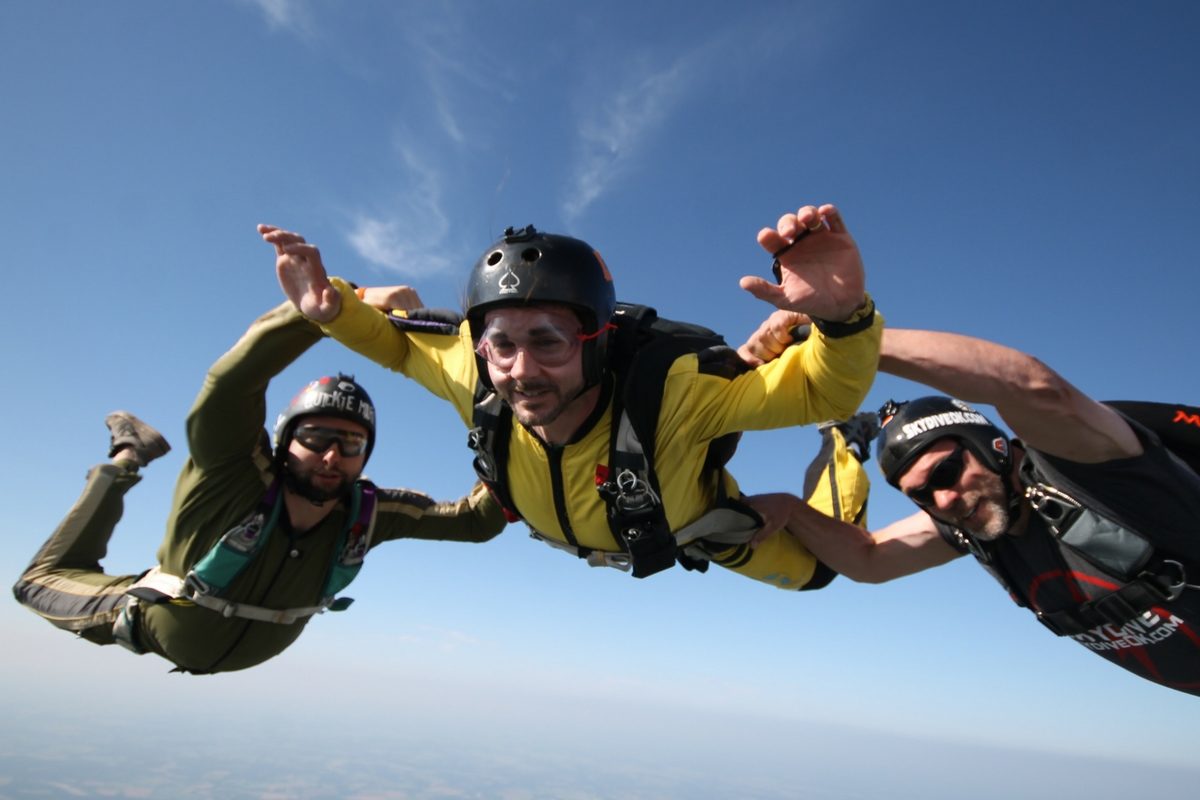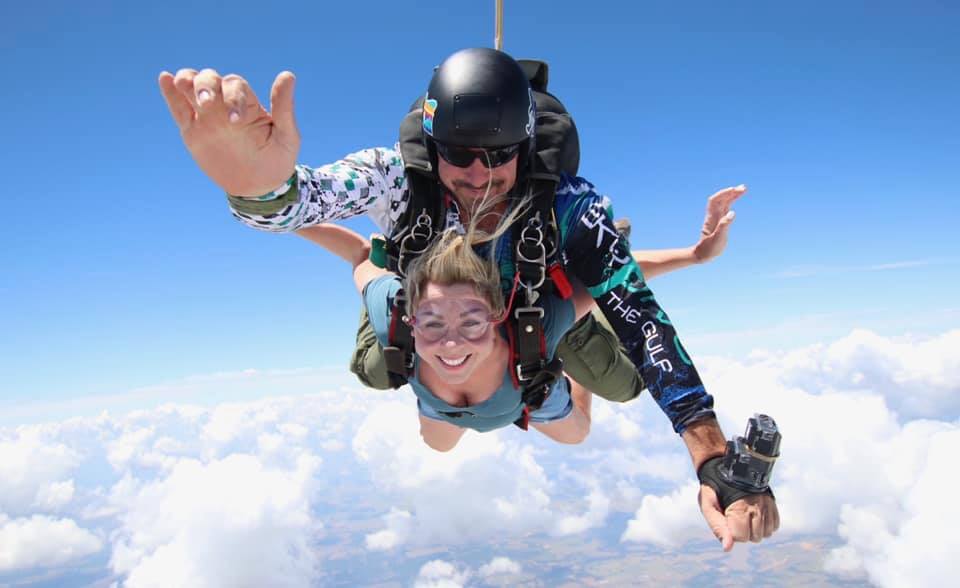Skydiving License Levels Explained
Wednesday, February 28, 2024
Skydiving is more than a thrilling adventure; it is a sport that demands precision, passion, skill, and above all, safety. As the adrenaline rush of freefall captures the hearts of many, it’s important to recognize that none of it would be possible without the structured training, dedication, and mandatory licensing that goes into ensuring a successful and enjoyable experience for everyone involved. And it all begins with the first skydiving license level!
Let’s dissect each of the skydiving license levels and talk about what it takes to achieve a skydiving instructional rating in order to make every sky-lover’s dreams come true!

Skydiving License Levels
There are four skydiving license levels you can achieve through the United States Parachute Association (USPA); A, B, C, and D – each giving you access to new opportunities for growth and adventure. Here is how to achieve each license and what you can do with each new level of licensure!
Skydiving A License
The A license is the first you will receive after completion of a USPA-qualified A license program, or Accelerated Freefall (AFF) Program. Once a student completes all of the items necessary to achieve an A license, they will officially become a full fledged skydiver capable of skydiving on their own or, better yet, with friends!
Skydiving A License Requirements:
- Must be over 18 years old
- Complete a minimum of 25 jumps
- Complete all requirements on the USPA A License Proficiency Card
- Make 5 skydive with one or more people
- Signed and stamped skydiving license card
- Pass the USPA A License written and oral exams
Skydiving B License
Once A-licensed jumpers get more comfortable in the sky, they can start to pursue other licenses within the skydiving realm. The next step would be achieving a skydiving B license, which gives you access to even more fun things like HALO jumps from high altitudes, night jumps, helicopter jumps, and hot air balloon jumps! Say whaaat!? Oh yes! And what’s even better, once a B-licensed jumper reaches 100 jumps they can qualify for their Coach rating to support others in their progression in the sport. How cool!
Skydiving B License Requirements:
- Meet all requirements for or hold a USPA A license
- Complete a minimum of 50 jumps with 30 minutes of controlled freefall time and landing within 33 feet of target center on 10 jumps
- Complete 10 formation skydives, or formation freefly skydives, at least 5 involving at least 3 participants
- Complete the requirements of the USPA Canopy Piloting Proficiency Card
- Documentation of live water training
- Pass the written USPA B License exam
Skydiving C License
A skydiving C license is the next step after achieving the B license. C licensed skydivers are considered to be relatively safe to fly with which opens the door for many more opportunities – this is when the real fun starts! C-licensed skydivers can jump with a camera which means you can finally show off your own epic footage. They also become eligible for wingsuiting, BASE jumping, pursuing a USPA Instructor rating, perform demonstration jumps, and be a passenger on a USPA Tandem Instructor training course and rating renewal jumps!
Skydiving C License Requirements:
- Meet all current requirement for or hold a USPA B license
- Complete 200 jumps, including at least 60 minutes of controlled freefall time and landing within 7 feet of target center on 25 jumps
- Complete 50 formation skydives, or formation freefly skydives, at least 10 involving at least 4 participants
- Pass the written USPA C License exam
Skydiving D License
The D license is the most advanced license of all of the skydiving license levels. Skydivers with a D license can do pretty much everything and work toward their pro and tandem ratings if they desire.
D License Requirements:
- Meet all current requirements or hold a USPA C license
- Complete 500 jumps, including 3 hours of controlled freefall time
- Compete at least 2 of the following skills:
- Night jump
- Land within 7 feet of target center on 100 jumps
- Participate in a canopy formation of a 3 stack or larger, completing a full rotation
- Complete an intentional water jump
- Complete 100 formation skydives, at least 25 involving at least eight participant
- Pass the written USPA D license exam
Quick Reference: Skydiving License Levels
Here is a quick reference table for each skydiving license level and their key requirements:
| Skydiving License Level | Minimum Number of Jumps | Minimum Freefall Time |
| Skydiving A License | 25 | – |
| Skydiving B License | 50 | 30 minutes |
| Skydiving C License | 200 | 60 minutes |
| Skydiving D License | 500 | 180 minutes |
Other Types of Skydiving Licenses & Ratings
When it comes to skydiving, there’s always more to learn and the ratings seem to never end! For those who are interested in going beyond a typical skydiving license or are interested in having a career in skydiving, they’ll need additional licenses and/or ratings. This could be a USPA Instructional rating, USPA PRO Exhibition rating, USPA Judge rating, and/or an FAA rating to become a certified parachute rigger, aircraft mechanic, or pilot!
USPA Instructional Ratings
USPA Instructional ratings progress from Coach to Instructor to Examiner. USPA Coaches can teach the general sections of the first-jump course and train/supervise students for group skydiving skills. AFF instructors can teach the full first-jump course and take students up on their first jumps, sign off licenses, and supervise/mentor coaches. USPA Tandem Instructors can take the general public on tandem skydives! The title of USPA Examiner is the highest instructional rating you can have in skydiving.
USPA Coach Rating Requirements:
- Complete at least 100 jumps
- Obtain a USPA B license
- Complete the Coach Certification Course
USPA AFF Instructor (AFF-I) Rating Requirements:
- Complete at least 200 jumps
- Obtain a USPA C license
- Obtain a Coach rating for 12 months or 500 jumps
- Size hours of freefall time
- Complete approved AFF-I Rating Course

USPA Tandem Instructor Rating Requirements:
- Hold or has held any USPA Coach or Instructional rating
- Obtain a USPA D license
- Complete 500 jumps on a ram-air canopy
- Complete 100 jumps in the last 12 months
- Minimum of 3 years in parachuting
- Present a FAA Class 3 Medical Certificate
- Complete approved Tandem Instructor Course
Restricted USPA Licenses
Our sport does a pretty good job of being an inclusive sport for all to enjoy the freedom of flying. Which is why under some extreme circumstances, such as differing physical abilities, a USPA Restricted License may be issued to approved applicants. A person may be qualified for a Restricted License if the applicant has all of the following:
- Submit a petition to the Safety & Training Committee, containing:
- Type of license requested
- Specific license requirements that cannot be met
- Circumstances preventing compliance with license requirements
- License application completed, except for the restricted activities
- Meet all requirements for the license desired excluding the ones listed in the petition
Skydiving Disciplines

Once you have your skydiving license, you can explore the limitless world of skydiving and all of its different disciplines. Here are the most popular skydiving disciplines that you could get into:
- Formation Skydiving
- Freeflying
- Angle Flying
- Wingsuiting
- Canopy Piloting
- Swooping
- Canopy Relative Work (CRW)
Whether you are ready to start working towards your A license, want to learn how to BASE jump, or want to tandem jump out of our super sick Turbine 206, get in touch with our helpful team members at Oklahoma Skydiving today or book a skydive online! Blue skies.
Copyright © 2024, Oklahoma Skydiving Center, All Rights Reserved.
DropZone Web Design & Marketing by Beyond Marketing, LLC





